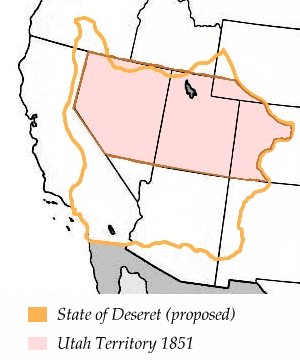State of Deseret
|
|
The State of Deseret was a provisional state of the United States, proposed in 1849 by Mormon settlers in Salt Lake City. The provisional state existed for slightly over two years and was never recognized by the United States government. The name derives from the word for "honeybee" in the Book of Mormon.
(see Deseret)
| Contents |
History
Formation of the Proposal
When members of the Church of Jesus Christ of Latter-Day Saints (the Mormons) settled in the valley of the Great Salt Lake, they wished to set up a government that would be recognized by the United States.
Initially Brigham Young, President of the LDS Church, had intended to apply for status as a territory, and had sent John M. Bernhisel eastward to Washington, D.C. with the petition for territorial status. Realizing that California and New Mexico were applying for admission as states, Young changed his mind and decided to petition for statehood.
In March 1849, realizing that they did not have time to follow the usual steps towards statehood, Young and a group of church elders quickly drafted a state constitution based on that of Iowa, where the Mormons had temporarily settled, and sent the legislative records and constitution back to that state for printing, since no printing press existed in the Great Basin at the time. They then sent a second messenger with a copy of the state's formal records and constitution to meet up with Bernhisel in Washington, D.C. and petition for statehood rather than territorial status.
Territory of Deseret
The provisional state was a bold proposal, encompassing most of the territory that had been acquired from Mexico the previous year, as the Mexican Cession.
It comprised roughly all the lands between the Sierra Nevada and the Rockies, and between the border with Mexico northward to include parts of the Oregon Territory, as well as the coast of California south of the Santa Monica Mountains (including the existing settlements of Los Angeles and San Diego). It included the entire watershed of the Colorado River (excluding the lands south of the border with Mexico), as well as the entire area of the Great Basin.
The proposal encompassed most nearly all of present-day Utah and Nevada, large portions of California and Arizona, and parts of Colorado, New Mexico, Wyoming, Idaho, and Oregon.
The proposal was crafted specifically to avoid disputes that might arise from existing settlement. At the time of its proposal, the existing population of the area, including Southern California, was sparse, since most of the California settlement had been in the northern gold rush areas not included in the provisional state. Likewise the border with New Mexico did not reach to the Rio Grande, in order to avoid becoming entangled in the existing disputes of the western border of Texas.
Moreover, the proposal encompassed lands largely known to be inhospitable for cultivation, thus avoiding conflict over the issue of the expansion of slavery.
The proposal for the state was largely considered too ambitious to succeed in Congress, even disregarding the controversy over Mormon practices such as polygamy. Nevertheless, in 1849 President Zachary Taylor, eager to avoid disputes as much as possible, sent his agent John Wilson westward with a proposal to combine California and Deseret as a single state, which would have the desirable effect of decreasing the number of free states entered into the Union, and thus preserving the balance of power in the Senate.
Government
In the absence of other authority, the provisional government of Deseret became the de facto government of the Great Basin. Three sessions of the General Assembly, a bicameral state legisture, were held. In 1850, the legislature appointed judges and established a criminal code. Taxes were established on property and liquor, and gambling was outlawed. The Church of Jesus Christ of Latter-day Saints was incorporated, and a militia, based on the Nauvoo Legion, was formed.
The legislature initially formed six counties, which covered only inhabited valleys. These "valley counties" initially encompassed only a small portion of the area of Deseret and were expanded and settlement grew [1] (http://dmla.clan.lib.nv.us/docs/nsla/archives/political/historical/hist04.htm).
Establishment of Utah Territory
In September 1850, as part of the Compromise of 1850, the Utah Territory was created by Act of Congress, encompassing a portion of the northern section of Deseret.
February 3, 1851, Brigham Young was inaugurated as the first governor of the Utah Territory. On April 4, 1851 the General Assembly of Deseret passed a resolution to dissolve the state. On October 4, the Utah territorial legislature voted to re-enact the laws and ordinances of the State of Deseret.
After the establishment of the Utah Territory, the Mormons did not relinquish the idea of the State of Deseret. Attempts were made in 1856, 1862, and 1872 to write a new constitution for the state based on the new boundaries of the Utah Territory. From 1862 to 1870, a group of Mormon elders under Young's leadership met as a shadow government after each session of the territorial legislature to ratify the new laws under the name of the "State of Deseret."
The idea of creating a state based on Mormonism began to dissolve after the coming of the railroad, which opened the territory to many non-Mormon settlers, particularly in the western areas of the territory. The driving of the golden spike to complete the first transcontinental railroad at Promontory Point in 1869 was boycotted by church elders and territorial officials.
See also
External links
- State of Nevada: Utah Territory (http://dmla.clan.lib.nv.us/docs/nsla/archives/political/historical/hist04.htm)
- Utah History Encyclopedia: State of Deseret (http://historytogo.utah.gov/deseret.html)

